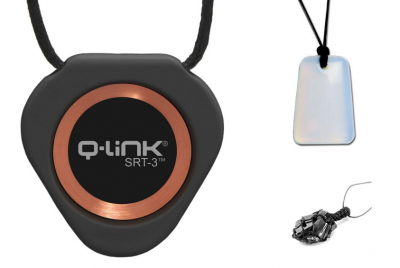When worn correctly, both Bluetooth and wired earbuds offer a lightweight and comfortable way to listen…
The Most Effective EMF Shielding Materials and How To Use Them

*We may earn a commission for purchases made using our links. Please see our disclosure to learn more.
When it comes to EMF radiation, eliminating exposure is not always a realistic option. Even if you are actively taking steps to reduce your cell phone usage, switching to wired internet, and doing everything else possible, there are still many factors beyond your control. Your neighbor’s WiFi signal or smart meter, for example, could very well be reaching the interior of your home.
In these instances, shielding materials can be of particular value. Whether you choose to hang shielding material on your walls or use them to create protective items, they can reduce the amount of EMF radiation entering your home.
Over the course of this guide, we will take a look at how EMF shielding materials work. We will also dive into some of the more popular materials out there and ideas on how to use them.
Let’s get started.
EMF shielding materials
In general, electromagnetic fields are difficult to effectively block. These fields are a type of non-ionizing radiation, which, unlike its ionizing counterpart, isn’t simply discouraged by dense materials. Rather, with EMF radiation, we want to focus on attenuating the frequency. So what does that mean?
Attenuate is simply a fancy word for reduce. EMF shielding materials aim to reduce EMF radiation by blocking some of it. In order to do this, the material in question must have some level of conductivity to it. Essentially, electric and magnetic fields carry an electrical charge. When they meet a conductive surface, the electrical current is disrupted and the electric and magnetic fields are unable to pass through.
Granted, the conductive surface usually does not completely block out all EMF radiation. But it does attenuate a degree of it, depending on the material. Faraday cages are one example of attenuation at work — they allow some signals to pass through holes in the metal mesh, while other, less desirable frequencies are prevented from escaping.
Popular EMF shielding materials
While it’s true that any conductive metal can be used as an EMF shielding material, some are more popular and cost-effective than others. You probably won’t find a Faraday cage made from pure gold, for example, even though it’s one of the most conductive metals out there. That is because gold is expensive and not readily available.
So what are some better shielding materials?
Copper
Copper is the 29th element on the periodic table. It is considered a transition metal, and when found in nature it’s actually quite soft, at least as far as metals go. Natural copper may be a vibrant reddish orange color or it could even have pink hues. Humans have been using copper for thousands of years for a variety of purposes, including weaponry, building materials, jewelry, coins, and even binding with other metals.
Another relevant characteristic of copper is its conductivity. It is in the same periodic table group as gold (group 11,) and it is similarly conductive. Furthermore, it is much more readily available than gold, making it a much better choice for a shielding material.
If you’re looking to use copper to attenuate EMF radiation in your home, consider Amradield’s Copper Fabric. Capable of reducing microwaves, radiofrequency waves, and other forms of EMF radiation, this copper fabric is versatile and effective at attenuating frequencies between 30MHz and 18GHz. Each strip of fabric measures in at 43 inches wide by 39 inches long, although it can easily be cut with scissors to create a custom size.
Mylar
Mylar is somewhat of an outlier on our list as it’s not actually a conductive metal. Rather, mylar is a polyester film that is used for a wide array of things. From emergency blankets to food packaging, mylar is even useful in shielding against EMF radiation.
Created by an industrial process, mylar starts as superheated liquid polyethylene terephthalate (PET). The PET is squeezed onto a roll where it settles and heated rollers are used to draw out the newly formed film in different directions — stretching it, basically. Extreme heat is then applied, allowing the mylar to solidify. Some type of additive, from silicone dioxide to different types of metals, is then added to the film in order to make it easier to handle.
And while it is not a conductive metal, mylar is commonly used to insulate electric material. Granted, there are not many EMF protective items out there that utilize mylar. But it is quite affordable and easy to find, making it perfect for DIY shielding projects.
One option if you’re going the mylar route are the emergency blankets from Swiss Safe. Each blanket is 52 inches by 82 inches, making it large enough for many different applications. For best results, you can even double up on the mylar.
Galvanized steel
To understand what galvanized steel is, let’s first break it down into two components.
First, steel. Steel is a manmade metal, produced by smelting (or heating) iron ore and removing some of the subsequent carbon. Sometimes, the steel is cast into ingots. More often in modern times, however, the steel is made into long slabs using a continuous casting process. The end result is a metal that is strong and also conductive.
Steel becomes galvanized, meanwhile, when a coating of zinc is applied. Usually this is done by dipping steel in a tub of molten zinc and then allowing it to cool. The purpose of this is to reinforce and protect the steel from corrosion.
Galvanized steel is usually sold in sheets. M-D Building Products sells their galvanized steel in one foot by two foot wide sheets that can easily be cut with tin snips. They recommend using special sheet metal screws to attach the sheet to a wall or other surface.
Aluminum foil
As the name suggests, aluminum foil is derived from the metal aluminum. During production, aluminum is cast into sheet ingots and then pressed between rollers until the appropriate thickness for the foil is achieved. You can find aluminum foil as either shiny or matte. In general, the shinier the foil, the more effective it is against EMF radiation, so it’s preferable to find the most reflective foil possible.
Aluminum itself is a conductive metal, and this property is passed on to foil. Aluminum foil is most effective against higher frequencies, as lower ones may be able to pass through. Still, it is a common material to use in electromagnetic shielding and EMF protection.
RadiantGUARD makes an excellent reflective and industrial-grade aluminum foil. Their rolls are quite large — 48 inches by 250 feet, to be exact — making them ideal for even large-scale projects. Each 1,000 square feet roll weighs in at 28 pounds, and it is commonly used as a building material. It’s also much stronger than your typical kitchen foil, and requires a hacksaw or a sharp pair of scissors to cut.
Aerogel
Aerogels are a unique, newer material that has been shown by Swiss scientists to be, quite possibly, the lightest shielding material out there. So what is it?
Essentially, aerogel is a mixture of cellulose and silver nanowires. This combination combines to create a material that is super lightweight and highly conductive from 8 GHz to 12 GHz. This newer technology is not yet readily available, but it is worth keeping an eye on.
Part of aerogel’s conductivity is due to its silver component. Silver is the 47th element on the periodic table, and it is part of that same group as gold and copper. That means that it is also highly conductive and very capable of electromagnetic shielding.
Testing your material
If you want to put your EMF shielding material to the test, you need an EMF meter. These devices are capable of measuring any surrounding electromagnetic radiation. Our favorite entry-level model is the TF2, from TriField. We go over the TF2 in much more depth in our review. For other models of EMF meters, see EMF Meters For Any Budget.
Measuring EMF radiation using your meter is simple. For the most part, turn your EMF meter on and switch it to the appropriate setting that you want to measure (for the TF2, for example, you can choose between standard electric and magnetic, weighted electric and magnetic, and RF). To fully test your material, you may even want to do multiple measurements for electric, magnetic, and RF radiation.
First, take a measurement before installing your shielding material on any walls. This gives you a base amount of EMF present in that area. Next, install the shielding material and repeat the process. If the material is shielding effectively, the amount of EMF radiation present should drop after the material is installed.
If you don’t want to purchase an EMF meter, there is another test you can try to see just how effective your material is. Take your cell phone and wrap it in the material. For this initial test, wrap it in just one layer, but make sure all sides are completely covered. Then, use a second phone to call the wrapped phone. If the call goes through, that tells you a signal can penetrate the material. Try wrapping it in another layer and repeating the experiment. This can even give you some idea of how many layers of material you need.
Final thoughts
There are many EMF shielding materials out there. The right one for you depends a great deal on what you’re using it for, as well as personal preference and what materials you have readily available. Even if a material says that it is conductive and capable of shielding electromagnetic fields, it is always a good idea to test it with an EMF meter, as well.



